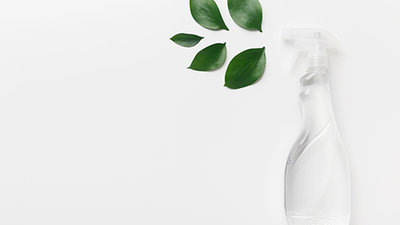People like green things. It’s a trendy, enticing, and commonly misleading marketing technique to label a product or thing as Green. You can find “Green” versions of a range of things including skin care products, mattresses and bedding, and cleaning products, among many other items. Companies recognize that consumers want green products, and are willing to pay a premium for them.
When a product is carefully named or labeled to evoke trust so that it SOUNDS like it’s safe, eco-friendly, and not harmful to humans, animals, and the environment without actually possessing those qualities, it is often called “Greenwashing”. Greenwashing has become increasingly more common as people have grown in their desire to protect the planet, and as people are willing to spend more money on green products made of naturally derived materials – especially for cleaning products because so many traditional, popular cleaning products are known to be harmful to people’s health and to the environment.

What makes a product genuinely Green?
When a person buys a “green” cleaning product, the motivation is to avoid exposure to harm. A green product should have substantially lower environmental impact and harm to living organisms. Shopping just by a product’s name or label won’t protect you from harm though. It’s not the label or the product name that makes a product safe, it’s the ingredients and materials inside.
Therefore, we have to set aside the idea of “Green” and focus on the idea of “Safe”. How do we assess what is safe?
A safe product will be made using only natural, not-toxic, and biodegradable ingredients.
Sometimes “green” products will contain MOSTLY natural materials, yet will also have SOME synthetic material as well. Certain green certifications actually allow for an acceptable amount of synthetics to pass that certification. They may be “green” according to a certain governing agency, but a product should ultimately pass YOUR certification process.
The cleaning product niche is so loosely regulated, that in some cases a company can get away with labeling something as “Eco Friendly” just by putting a highly-toxic substance in a bottle that was made from recycled material.
The natural materials that are in the product should be safe substances you’re ok with exposure to
There are natural ingredients common in cleaning products, like petroleum based materials that can be carcinogenic and are common in cleaning products. It may be natural, but that doesn’t mean it’s not potentially harmful. This is another reason why ALL NATURAL is not the equivalent of TOTALLY HEALTHY FOR YOU. Again, a product should pass your personal certification process.
Conclusion
Most green products contain some synthetic and harmful ingredients, and even some of the natural ingredients may have adverse health and environmental effects. It is ultimately up to the consumer to be initially skeptical of any label like “Green”.
While a truly green product is very likely to call itself green, the label is only the starting point of the selection process. From there, we need to filter through products, initially avoiding harmful synthetic ingredients, then further avoiding natural ingredients with the potential for harm. You’ll find the majority of products won’t make it through your own personal, more rigorous selection process.
Of course, the great danger of this marketplace confusion is the chance that unaware users exercise loose caution with harmful products because they trust the green labeling, and expose themselves to harm in the process, where they might have otherwise exercised greater caution if they understood the potential harm they were dealing with.




